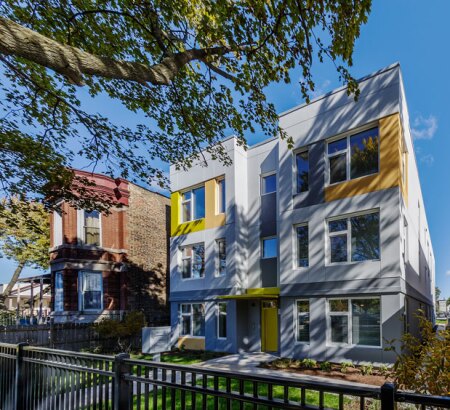
Tierra Linda is the first sustainability-oriented development created by the Latin United Community Housing Association, a Chicago-based nonprofit affordable housing organization. The six-flat building certified by Passive House houses six low-income families and was completed in 2018. (BALLOGGPHOTO.COM)
Incorporation of greener building practices is a priority for the Latin United Community Housing Association (LUCHA), a community housing development organization founded in Chicago in 1982 to serve members of low- and moderate-income Latinx and Black communities. The organization has built and manages four multifamily developments, providing nearly 200 units of affordable apartments in a city of nearly 3 million people.
In 2018, thanks to a state energy grant, LUCHA completed a new six-flat building that earned PHIUS+ certification from Passive House Institute US Inc. (PHIUS) with high levels of insulation, an airtight building envelope, and highly efficient heating and cooling systems to lower energy costs. Bringing the same level of emphasis on environmental concerns to the rehabilitation of existing developments, however, can be a challenge because of cost, structural, space, and zoning constraints.

In Chicago’s Humboldt Park, LUCHA is replacing the hot-water baseboard heating system with a more energy-efficient high-efficiency variable refrigerant flow system with heat recovery, which also provides much-needed air conditioning in a single-room occupancy building which will house 65 residents. (LUCHA/Charlene Andreas)
This year, LUCHA began rehabilitating its Humboldt Park Residence property. Designed by local firm Landon Bone Baker Architects and built in 1995 to provide 68 single-room-occupancy (SRO) apartments for previously homeless or low-income residents, the building incorporates on-site supportive services and community space. Bathrooms are shared between two units. The rehabilitation, also being performed by Landon Bone Baker, will give each unit its own bathroom.
“We need to recapitalize the building in order to keep it affordable, and the funding sources nowadays require each room to have a private bathroom,” says Charlene Andreas, LUCHA’s director of affordable housing. As part of the project, LUCHA is replacing the hot-water baseboard heating system with a more energy-efficient high-efficiency variable refrigerant flow (VRF) system with heat recovery, which also provides much-needed air conditioning.
The desire to maintain as many units as possible guided LUCHA’s choice of system. To make room for additional bathrooms, the number of units already has to be reduced to 65.
“Right now, the city of Chicago is losing SRO units at an alarming rate,” Andreas says. “We did not want to take out more units just to put in a fan coil system.” In addition to reducing energy costs and giving tenants individual temperature control, the VRF system does not take up floor space in the units. “A PTAC [packaged terminal air conditioner] was also a space concern due to projection into the unit.”
Because LUCHA pays the utility costs for residents, the organization was willing to pay the higher upfront costs for the VRF system. “We are also making the building all electric—except for the central hot-water heater, due to the existing infrastructure and location of that equipment,” Andreas says. However, “we were not able to add exterior wall insulation due to space, structure, and budget constraints,” she says. “Fairly early on, we talked with the Rocky Mountain Institute about a panelized system that we could add to the exterior walls, but because of Chicago’s setback requirements, and because the building comes right up to the property line, we didn’t have the option of adding even four inches [10.2 cm] to the footprint.”
The organization recently submitted a competitive tax credit application for the adaptive use of a church building in Chicago’s Logan Square neighborhood, a project that faces similar constraints. The church was constructed in the 1920s with 12 apartments, which the congregation manages as affordable housing. LUCHA proposes to rehabilitate them and insert 10 additional units in the former sanctuary and fellowship hall. LUCHA plans to keep the existing central boiler, which the church had recently replaced, but otherwise, “the design scheme that we included in the application involves going all electric, as much as possible,” Andreas says.
Because of the building’s size, it would have cost too much to add insulation to existing interior walls. “This is really an issue of trying to stay within the unit cost limits of the Low Income Housing Tax Credit qualified allocation plan [QAP] and our lenders,” says Andreas. “The adaptive reuse of the sanctuary has limited our work across the project. Because the sanctuary needs to be converted to dwelling units, there is more work and cost on that portion of the building.”
Rehabilitating and adapting existing buildings is inherently sustainable, reducing the number of new building materials required and the energy involved in transporting them to the site. Andreas is part of a coalition advocating for the Illinois Housing Development Authority (IHDA) to better incentivize advanced green building standards such as the PHIUS passive building certification as part of the authority’s QAP.
“It is looking like our recommendations will be implemented in the 2021 QAP, which is a big step forward,” Andreas said. “For rehabilitation projects, however, it can be a struggle because it is so competitive to get these tax credits. We want IHDA to consider giving a certain number of points just for preserving an existing building because of the embodied carbon that is saved.”
Learn more about innovative developments in Chicago at the upcoming ULI Fall Meeting.





